Researchers Dr. Yuval Hart and Oded Wertheimer from the Psychology department and the Edmond and Lily Safra Center for Brain Science (ELSC) at The Hebrew University of Jerusalem have developed a new computational model to explain neural and behavioral differences in autism spectrum disorder. This model offers fresh insights into information processing in the brains of individuals with autism spectrum disorder, opening new avenues for future research and understanding.
Autism spectrum disorder is known to present unique neural and behavioral characteristics compared to neurotypical individuals, but the underlying computational mechanisms remain complex and multifaceted. The model proposed by Dr. Hart and Wertheimer centers around the concept of “dynamic range” within neuronal populations. Dynamic range refers to the range of signals for which neurons elicit discernible responses. In simpler terms, it reflects how gradually or sharply neurons respond to stimuli – a more gradual response entails an increased dynamic range.
Our model suggests that autism spectrum disorder is not a `broken cog in the machine`, but rather a spectrum of points on the computational tradeoff line between accurate inference and fast adaptation.” said Dr. Yuval Hart. “This computational trade-off proved to be a fruitful framework for explaining many of the neural and behavioral characteristics seen in autism.”
Dr. Yuval Hart, The Hebrew University of Jerusalem
The researchers found that an increased dynamic range, indicating a gradual response of a neuronal population to changes in input, accounts for neural and behavioral variations in individuals diagnosed with ASD across diverse tasks. This gradual response enables more accurate encoding of details but comes with a trade-off: slower adaptation to changes. By contrast, a narrower dynamic range allows for quick, threshold-based reactions, facilitating fast adaptation but potentially at the expense of fine discrimination.
Testing their model across diverse simulations and behavioral tasks, including finger-tapping synchronization, orientation reproduction, and global motion coherence, the researchers demonstrated that increased dynamic range might underlie certain autism spectrum disorder-related behaviors. This variation in response could stem from differences in how individual neurons activate. For instance, increased variability in individual neurons’ half-activation point, the point where the neuron’s response is half of its maximal value, could lead to a broader dynamic range at the population level, influencing how sensory input is processed and interpreted by the brain.
“We show how heterogeneity in the half-activation points of single neurons can result in a more gradual population response and can thus lead to an increased dynamic range.” explained Oded Wertheimer. “Given the vast literature that maps autism spectrum disorder to mutations in genes related to neuronal receptors, the proposed biological mechanism is highly relevant – many sources of heterogeneity in these neuronal features can lead to increased dynamic range. This model provides a new lens for understanding autism spectrum disorder, one that bridges biological mechanisms at the neuronal level with computational principles.”
Dr. Hart and Wertheimer’s findings also provide insight into why autism spectrum disorder research often yields conflicting results. Differences in the dynamic range within the autism spectrum disorder population may contribute to the variation in findings across studies, highlighting the need for larger participant groups to ensure robust results.
Their model aligns with existing theories that relate autism spectrum disorder to atypical sensory processing, supporting a connection to broader biological and genetic factors. Specific genetic mutations associated with autism spectrum disorder, such as those affecting synaptic regulation, may contribute to this increased dynamic range. These biological factors could lead to a more variable neuronal response, creating the nuanced, analog-like encoding seen in autism spectrum disorder individuals.
By exploring this computational trade-off, the study not only introduces a new perspective on autism spectrum disorder but also suggests future directions for study. The researchers propose that examining this dynamic range at different developmental stages, or through animal models, could further clarify its impact on autism spectrum disorder-related behaviors.
Wertheimer, O., & Hart, Y. (2024). Autism spectrum disorder variation as a computational trade-off via dynamic range of neuronal population responses. Nature Neuroscience. doi.org/10.1038/s41593-024-01800-6.
Source link : News-Medica

